fuel GMC YUKON HYBRID 2010 Owners Manual
[x] Cancel search | Manufacturer: GMC, Model Year: 2010, Model line: YUKON HYBRID, Model: GMC YUKON HYBRID 2010Pages: 120, PDF Size: 1.03 MB
Page 3 of 120
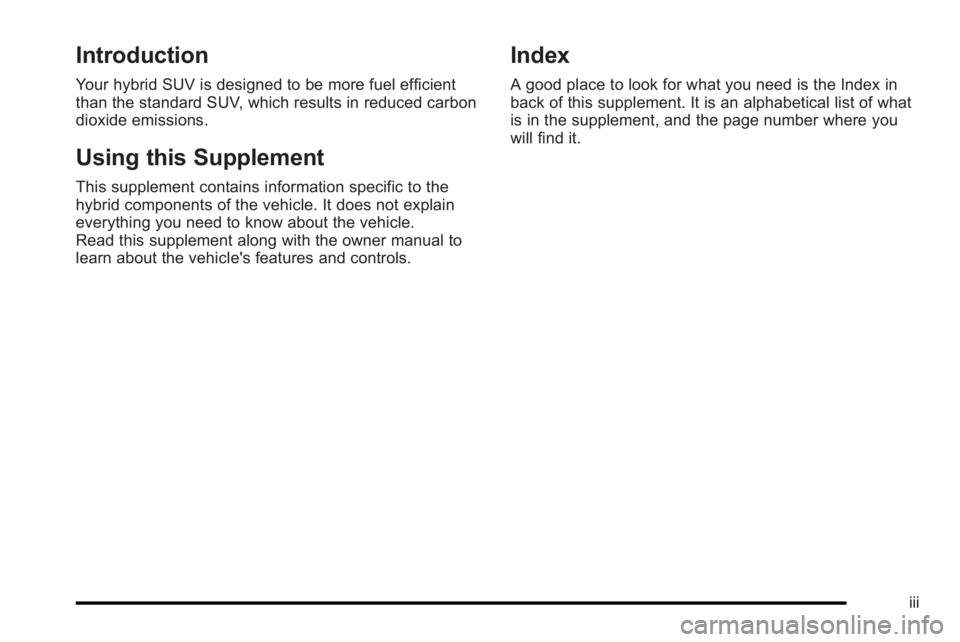
Introduction
Your hybrid SUV is designed to be more fuel efficient
than the standard SUV, which results in reduced carbon
dioxide emissions.
Using this Supplement
This supplement contains information specific to the
hybrid components of the vehicle. It does not explain
everything you need to know about the vehicle.
Read this supplement along with the owner manual to
learn about the vehicle's features and controls.
Index
A good place to look for what you need is the Index in
back of this supplement. It is an alphabetical list of what
is in the supplement, and the page number where you
will find it.
iii
Page 5 of 120

Section 1 In Brief
Initial Drive Information. . . . . . . . . . . . . . . . . . . . . . . . . . . 1-2
Transmission . . . . . . . . . . . . . . . . . . . . . . . . . . . . . . . . . . . . 1-2
Four-Wheel Drive . . . . . . . . . . . . . . . . . . . . . . . . . . . . . . . 1-2
Hybrid Features . . . . . . . . . . . . . . . . . . . . . . . . . . . . . . . . . . . . 1-3
Hybrid Safety Information . . . . . . . . . . . . . . . . . . . . . . 1-3
Fuel Economy Gage . . . . . . . . . . . . . . . . . . . . . . . . . . . . 1-4 Automatic Engine Start/Stop Feature . . . . . . . . . . . . 1-4
Regenerative Braking . . . . . . . . . . . . . . . . . . . . . . . . . . . 1-5
Battery . . . . . . . . . . . . . . . . . . . . . . . . . . . . . . . . . . . . . . . . . . 1-6
Service . . . . . . . . . . . . . . . . . . . . . . . . . . . . . . . . . . . . . . . . . 1-6
Performance and Maintenance . . . . . . . . . . . . . . . . . . . .1-6
Tire Sealant and Compressor Kit . . . . . . . . . . . . . . . . 1-6
1-1
Page 8 of 120
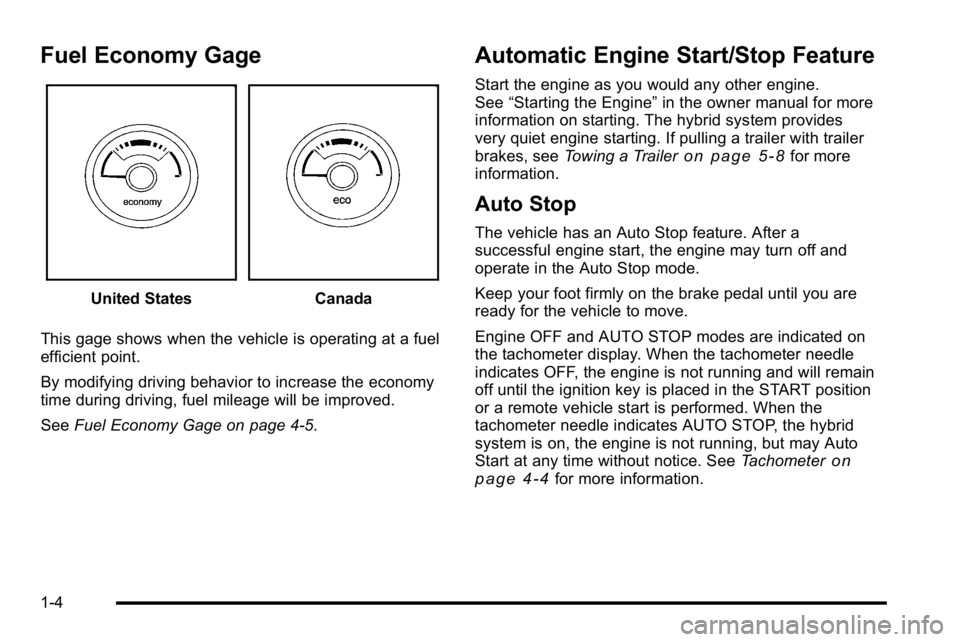
Fuel Economy Gage
United StatesCanada
This gage shows when the vehicle is operating at a fuel
efficient point.
By modifying driving behavior to increase the economy
time during driving, fuel mileage will be improved.
See Fuel Economy Gage on page 4‑5.
Automatic Engine Start/Stop Feature
Start the engine as you would any other engine.
See“Starting the Engine” in the owner manual for more
information on starting. The hybrid system provides
very quiet engine starting. If pulling a trailer with trailer
brakes, see Towing a Trailer
on page 5‑8for more
information.
Auto Stop
The vehicle has an Auto Stop feature. After a
successful engine start, the engine may turn off and
operate in the Auto Stop mode.
Keep your foot firmly on the brake pedal until you are
ready for the vehicle to move.
Engine OFF and AUTO STOP modes are indicated on
the tachometer display. When the tachometer needle
indicates OFF, the engine is not running and will remain
off until the ignition key is placed in the START position
or a remote vehicle start is performed. When the
tachometer needle indicates AUTO STOP, the hybrid
system is on, the engine is not running, but may Auto
Start at any time without notice. See Tachometer
on
page 4‑4for more information.
1-4
Page 9 of 120
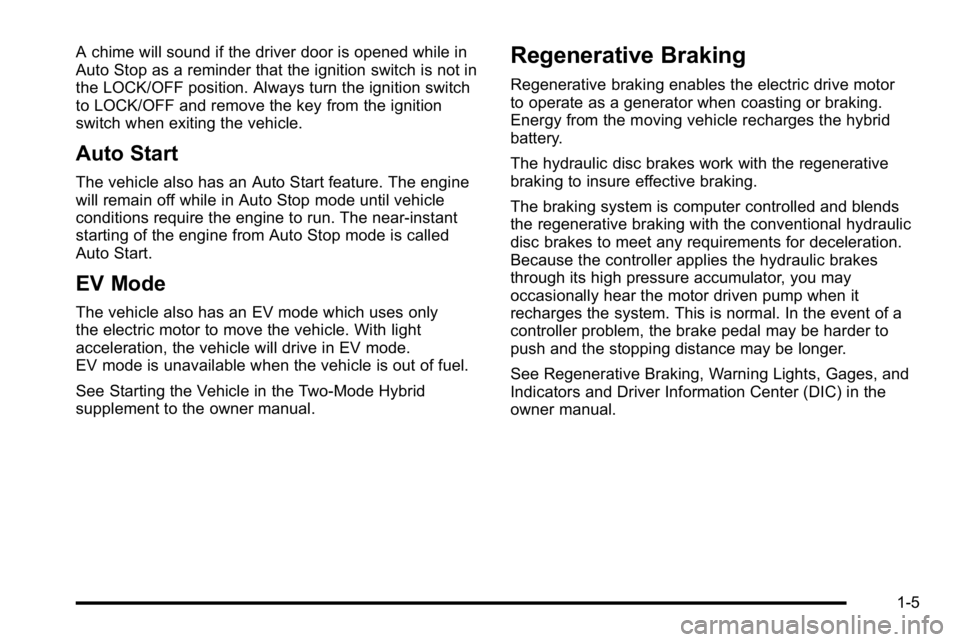
A chime will sound if the driver door is opened while in
Auto Stop as a reminder that the ignition switch is not in
the LOCK/OFF position. Always turn the ignition switch
to LOCK/OFF and remove the key from the ignition
switch when exiting the vehicle.
Auto Start
The vehicle also has an Auto Start feature. The engine
will remain off while in Auto Stop mode until vehicle
conditions require the engine to run. The near-instant
starting of the engine from Auto Stop mode is called
Auto Start.
EV Mode
The vehicle also has an EV mode which uses only
the electric motor to move the vehicle. With light
acceleration, the vehicle will drive in EV mode.
EV mode is unavailable when the vehicle is out of fuel.
See Starting the Vehicle in the Two‐Mode Hybrid
supplement to the owner manual.
Regenerative Braking
Regenerative braking enables the electric drive motor
to operate as a generator when coasting or braking.
Energy from the moving vehicle recharges the hybrid
battery.
The hydraulic disc brakes work with the regenerative
braking to insure effective braking.
The braking system is computer controlled and blends
the regenerative braking with the conventional hydraulic
disc brakes to meet any requirements for deceleration.
Because the controller applies the hydraulic brakes
through its high pressure accumulator, you may
occasionally hear the motor driven pump when it
recharges the system. This is normal. In the event of a
controller problem, the brake pedal may be harder to
push and the stopping distance may be longer.
See Regenerative Braking, Warning Lights, Gages, and
Indicators and Driver Information Center (DIC) in the
owner manual.
1-5
Page 19 of 120
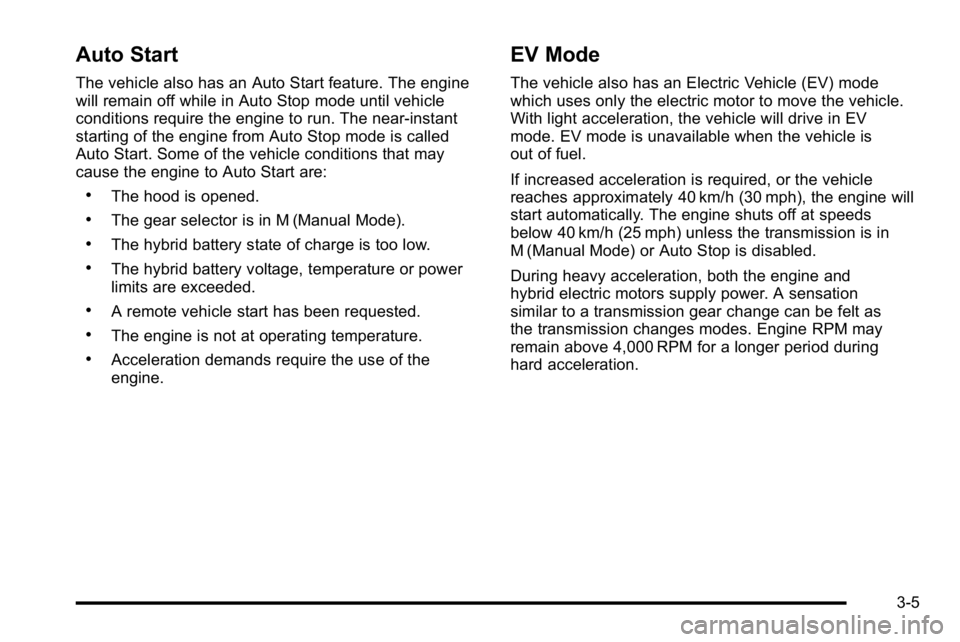
Auto Start
The vehicle also has an Auto Start feature. The engine
will remain off while in Auto Stop mode until vehicle
conditions require the engine to run. The near-instant
starting of the engine from Auto Stop mode is called
Auto Start. Some of the vehicle conditions that may
cause the engine to Auto Start are:
.The hood is opened.
.The gear selector is in M (Manual Mode).
.The hybrid battery state of charge is too low.
.The hybrid battery voltage, temperature or power
limits are exceeded.
.A remote vehicle start has been requested.
.The engine is not at operating temperature.
.Acceleration demands require the use of the
engine.
EV Mode
The vehicle also has an Electric Vehicle (EV) mode
which uses only the electric motor to move the vehicle.
With light acceleration, the vehicle will drive in EV
mode. EV mode is unavailable when the vehicle is
out of fuel.
If increased acceleration is required, or the vehicle
reaches approximately 40 km/h (30 mph), the engine will
start automatically. The engine shuts off at speeds
below 40 km/h (25 mph) unless the transmission is in
M (Manual Mode) or Auto Stop is disabled.
During heavy acceleration, both the engine and
hybrid electric motors supply power. A sensation
similar to a transmission gear change can be felt as
the transmission changes modes. Engine RPM may
remain above 4,000 RPM for a longer period during
hard acceleration.
3-5
Page 22 of 120
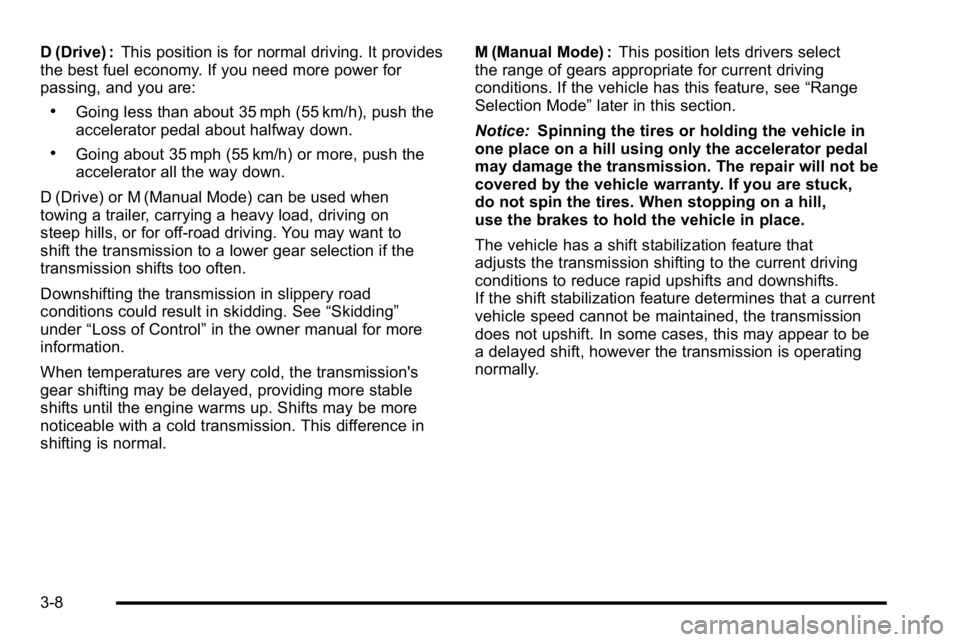
D (Drive) :This position is for normal driving. It provides
the best fuel economy. If you need more power for
passing, and you are:
.Going less than about 35 mph (55 km/h), push the
accelerator pedal about halfway down.
.Going about 35 mph (55 km/h) or more, push the
accelerator all the way down.
D (Drive) or M (Manual Mode) can be used when
towing a trailer, carrying a heavy load, driving on
steep hills, or for off-road driving. You may want to
shift the transmission to a lower gear selection if the
transmission shifts too often.
Downshifting the transmission in slippery road
conditions could result in skidding. See “Skidding”
under “Loss of Control” in the owner manual for more
information.
When temperatures are very cold, the transmission's
gear shifting may be delayed, providing more stable
shifts until the engine warms up. Shifts may be more
noticeable with a cold transmission. This difference in
shifting is normal. M (Manual Mode) :
This position lets drivers select
the range of gears appropriate for current driving
conditions. If the vehicle has this feature, see “Range
Selection Mode” later in this section.
Notice: Spinning the tires or holding the vehicle in
one place on a hill using only the accelerator pedal
may damage the transmission. The repair will not be
covered by the vehicle warranty. If you are stuck,
do not spin the tires. When stopping on a hill,
use the brakes to hold the vehicle in place.
The vehicle has a shift stabilization feature that
adjusts the transmission shifting to the current driving
conditions to reduce rapid upshifts and downshifts.
If the shift stabilization feature determines that a current
vehicle speed cannot be maintained, the transmission
does not upshift. In some cases, this may appear to be
a delayed shift, however the transmission is operating
normally.
3-8
Page 25 of 120
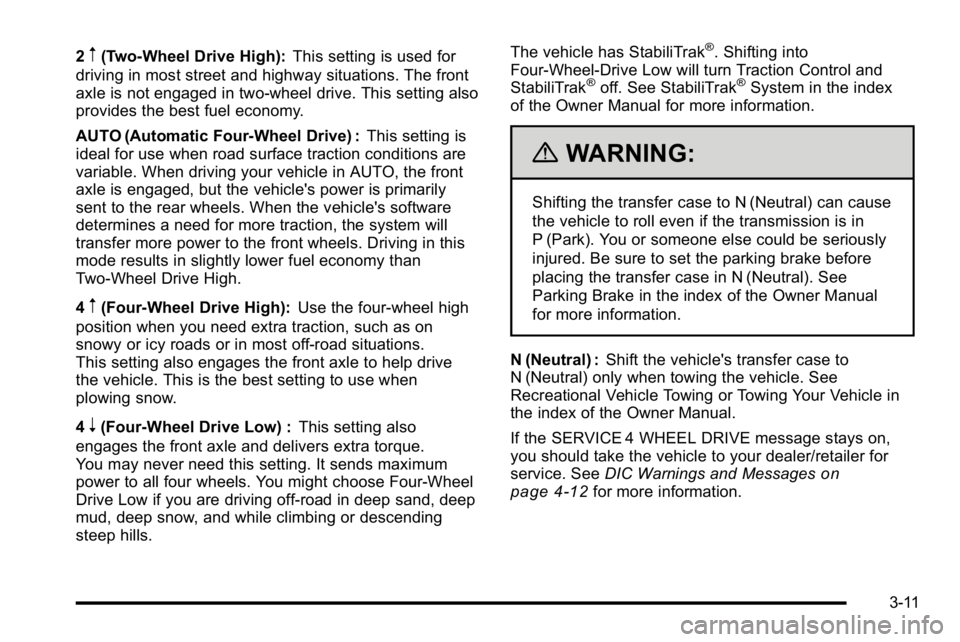
2m(Two-Wheel Drive High):This setting is used for
driving in most street and highway situations. The front
axle is not engaged in two-wheel drive. This setting also
provides the best fuel economy.
AUTO (Automatic Four-Wheel Drive) : This setting is
ideal for use when road surface traction conditions are
variable. When driving your vehicle in AUTO, the front
axle is engaged, but the vehicle's power is primarily
sent to the rear wheels. When the vehicle's software
determines a need for more traction, the system will
transfer more power to the front wheels. Driving in this
mode results in slightly lower fuel economy than
Two-Wheel Drive High.
4
m(Four-Wheel Drive High): Use the four-wheel high
position when you need extra traction, such as on
snowy or icy roads or in most off-road situations.
This setting also engages the front axle to help drive
the vehicle. This is the best setting to use when
plowing snow.
4
n(Four-Wheel Drive Low) : This setting also
engages the front axle and delivers extra torque.
You may never need this setting. It sends maximum
power to all four wheels. You might choose Four-Wheel
Drive Low if you are driving off-road in deep sand, deep
mud, deep snow, and while climbing or descending
steep hills. The vehicle has StabiliTrak
®. Shifting into
Four-Wheel-Drive Low will turn Traction Control and
StabiliTrak
®off. See StabiliTrak®System in the index
of the Owner Manual for more information.
{WARNING:
Shifting the transfer case to N (Neutral) can cause
the vehicle to roll even if the transmission is in
P (Park). You or someone else could be seriously
injured. Be sure to set the parking brake before
placing the transfer case in N (Neutral). See
Parking Brake in the index of the Owner Manual
for more information.
N (Neutral) : Shift the vehicle's transfer case to
N (Neutral) only when towing the vehicle. See
Recreational Vehicle Towing or Towing Your Vehicle in
the index of the Owner Manual.
If the SERVICE 4 WHEEL DRIVE message stays on,
you should take the vehicle to your dealer/retailer for
service. See DIC Warnings and Messages
on
page 4‑12for more information.
3-11
Page 31 of 120
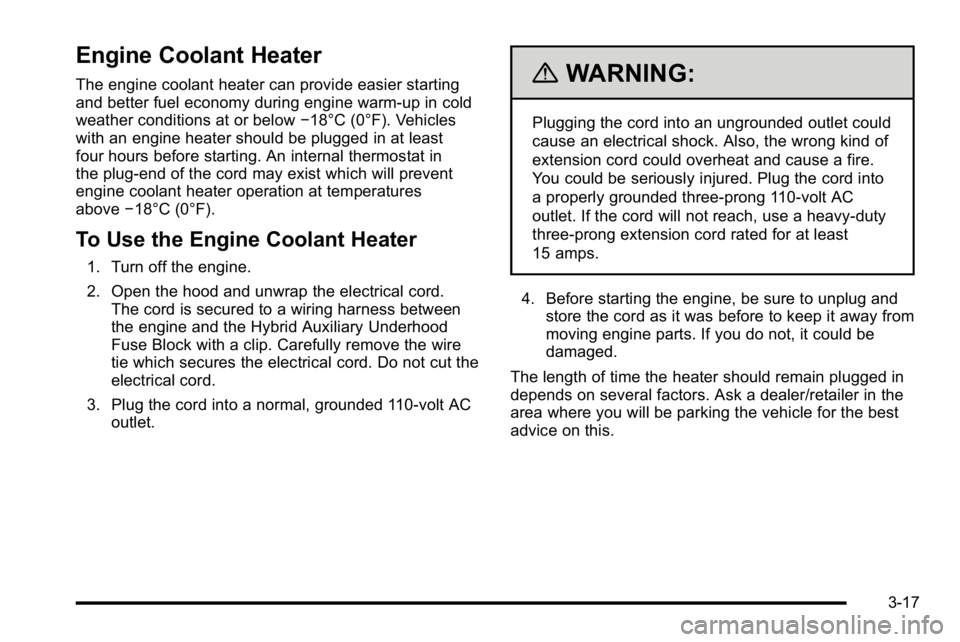
Engine Coolant Heater
The engine coolant heater can provide easier starting
and better fuel economy during engine warm-up in cold
weather conditions at or below−18°C (0°F). Vehicles
with an engine heater should be plugged in at least
four hours before starting. An internal thermostat in
the plug-end of the cord may exist which will prevent
engine coolant heater operation at temperatures
above −18°C (0°F).
To Use the Engine Coolant Heater
1. Turn off the engine.
2. Open the hood and unwrap the electrical cord.
The cord is secured to a wiring harness between
the engine and the Hybrid Auxiliary Underhood
Fuse Block with a clip. Carefully remove the wire
tie which secures the electrical cord. Do not cut the
electrical cord.
3. Plug the cord into a normal, grounded 110-volt AC outlet.
{WARNING:
Plugging the cord into an ungrounded outlet could
cause an electrical shock. Also, the wrong kind of
extension cord could overheat and cause a fire.
You could be seriously injured. Plug the cord into
a properly grounded three-prong 110-volt AC
outlet. If the cord will not reach, use a heavy-duty
three-prong extension cord rated for at least
15 amps.
4. Before starting the engine, be sure to unplug and store the cord as it was before to keep it away from
moving engine parts. If you do not, it could be
damaged.
The length of time the heater should remain plugged in
depends on several factors. Ask a dealer/retailer in the
area where you will be parking the vehicle for the best
advice on this.
3-17
Page 33 of 120
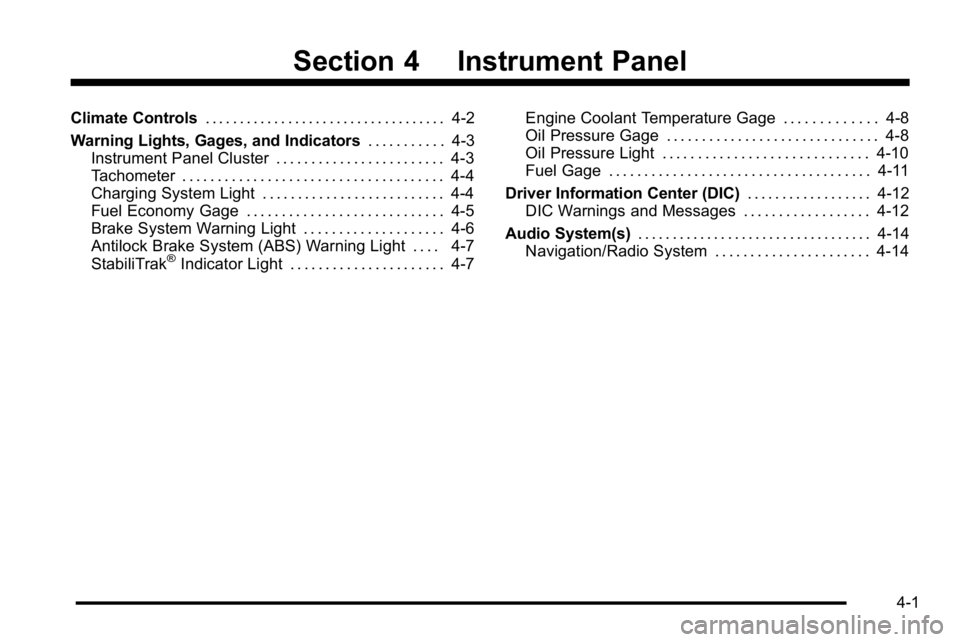
Section 4 Instrument Panel
Climate Controls. . . . . . . . . . . . . . . . . . . . . . . . . . . . . . . . . . . 4-2
Warning Lights, Gages, and Indicators . . . . . . . . . . .4-3
Instrument Panel Cluster . . . . . . . . . . . . . . . . . . . . . . . . 4-3
Tachometer . . . . . . . . . . . . . . . . . . . . . . . . . . . . . . . . . . . . . 4-4
Charging System Light . . . . . . . . . . . . . . . . . . . . . . . . . . 4-4
Fuel Economy Gage . . . . . . . . . . . . . . . . . . . . . . . . . . . . 4-5
Brake System Warning Light . . . . . . . . . . . . . . . . . . . . 4-6
Antilock Brake System (ABS) Warning Light . . . . 4-7
StabiliTrak
®Indicator Light . . . . . . . . . . . . . . . . . . . . . . 4-7 Engine Coolant Temperature Gage . . . . . . . . . . . . . 4-8
Oil Pressure Gage . . . . . . . . . . . . . . . . . . . . . . . . . . . . . . 4-8
Oil Pressure Light . . . . . . . . . . . . . . . . . . . . . . . . . . . . . 4-10
Fuel Gage . . . . . . . . . . . . . . . . . . . . . . . . . . . . . . . . . . . . . 4-11
Driver Information Center (DIC) . . . . . . . . . . . . . . . . . .4-12
DIC Warnings and Messages . . . . . . . . . . . . . . . . . . 4-12
Audio System(s) . . . . . . . . . . . . . . . . . . . . . . . . . . . . . . . . . . 4-14
Navigation/Radio System . . . . . . . . . . . . . . . . . . . . . . 4-14
4-1
Page 34 of 120
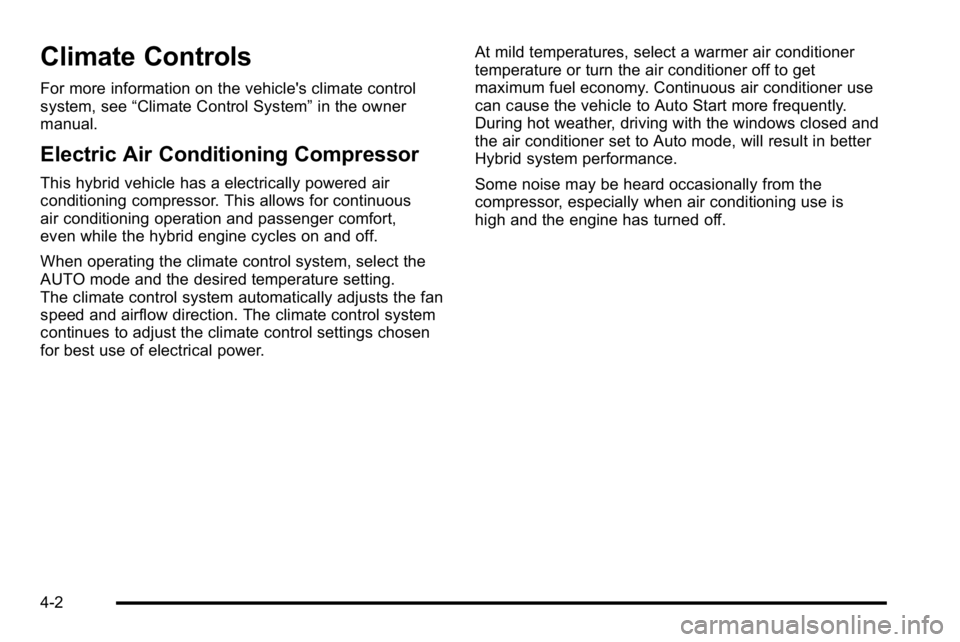
Climate Controls
For more information on the vehicle's climate control
system, see“Climate Control System” in the owner
manual.
Electric Air Conditioning Compressor
This hybrid vehicle has a electrically powered air
conditioning compressor. This allows for continuous
air conditioning operation and passenger comfort,
even while the hybrid engine cycles on and off.
When operating the climate control system, select the
AUTO mode and the desired temperature setting.
The climate control system automatically adjusts the fan
speed and airflow direction. The climate control system
continues to adjust the climate control settings chosen
for best use of electrical power. At mild temperatures, select a warmer air conditioner
temperature or turn the air conditioner off to get
maximum fuel economy. Continuous air conditioner use
can cause the vehicle to Auto Start more frequently.
During hot weather, driving with the windows closed and
the air conditioner set to Auto mode, will result in better
Hybrid system performance.
Some noise may be heard occasionally from the
compressor, especially when air conditioning use is
high and the engine has turned off.
4-2